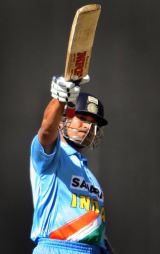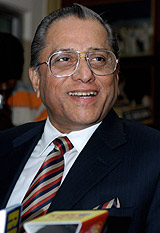A wind blows from the east
Mihir Bose
|
|

|
Napoleon's warning that the world should beware when China awakes has, in the last year, been translated into a wholly unexpected warning for the cricket world from another part of Asia - the Indian subcontinent. It has happened, not on the cricket field, but off it. On the field, the subcontinent has been a major power since 1971, when India won back-to-back series away from home in the West Indies and England. Sri Lanka's recent rise has merely confirmed this trend: three of the last four World Cups have been won by the subcontinent.
However, it is the money that the subcontinent can now generate through cricket that is posing a challenge to the established power centres. It is transforming the traditional image of the subcontinent as the land of magical spinners, wristy batsmen and (in Pakistan) devilish fast bowlers, into a place whose rich cricket administrators can dictate the future of the game.
This sounds like a contradiction. With a combined population of well over a billion, South Asia remains one of the poorest regions of the world. But while much of this population lives just above the poverty line, there is also a well-off nation within the poor one. Six hundred million Indians may not get more than a square meal a day; but India also has 250 million people - almost the population of the United States - with a standard of living not far behind that of the West. Inside the subcontinent's thin man, there is a fat man trying to get out - and desperate to advertise his wealth.
A hint of this had come in 1993 when India, Pakistan and Sri Lanka, after the most fractious meeting ever of the International Cricket Council, won the right to stage the 1996 World Cup. The key to victory was the way the three countries got the ICC's Associate Members - hitherto treated much as the Soviet Union used to treat its eastern European satellites - on their side by promising them £100,000 each. England, who believed they had a gentleman's agreement guaranteeing them the 1996 tournament, had offered £60,000 each, and throughout the meeting seemed to assume this was yet another cosy old boys' gathering. The Asians wheeled in politicians and lawyers and treated the event as if it were an American presidential convention. They outflanked England and won a rich prize. How rich only became evident when the 1996 World Cup began.
Unlike the Olympic Games, or soccer's World Cup and European Championships, the cricket World Cup is not an event owned by the international authority that runs the game. The country staging it, in effect, owns the competition. In five previous World Cups this had made little difference: the host country had made money, but not so much as to raise eyebrows. The 1996 World Cup changed everything.
As soon as they had won the competition the hosts set about selling it. Their biggest success was auctioning the television rights for a staggering $US14 million, using a hitherto unknown agent of Indian extraction based in the United States, Mark Mascarenhas. The UK rights alone fetched $7.5 million, compared to $1 million in 1992. In addition the tournament was marketed on a scale never before seen in cricket. There was an official sponsor for every conceivable product, including the official World Cup chewing gum.
A few years earlier, the world's most famous soft drink manufacturers had not even been allowed to sell their products in India. Now Coca Cola and Pepsi Cola battled it out to be the official drink supplier. Coke won - but they had to pay $3.8 million, more than Benson and Hedges paid the Australians to be the main sponsor of the 1992 World Cup. That role went to Wills, the Indian tobacco offshoot of BAT, who paid $12 million.
The organisers loved the rivalry. They were aware that they could keep all the profits, once they had met their expenses, which included a fee of £250,000 to each of the competing Test countries. This amount did not even cover the expenses of some of the teams, but the hosts pocketed a profit of almost $50 million. Contrast this with the 1996 European Championship of soccer in England: where UEFA, as owners of the championships, made a profit of £69 million, England, the hosts, made a loss of £1.7 million.
It could be argued that the cricket administrators of the rest of the world were naïve to agree to such an arrangement. But in five previous World Cups nobody had sought, let alone achieved, such commercial success. Not everyone on the subcontinent foresaw it. The Sri Lankans, co-hosts of the tournament along with India and Pakistan, clearly had doubts: they did not agree to underwrite the costs, so did not participate in any of the profits.
|
|
The man who drove the commercial juggernaut was Jagmohan Dalmiya, secretary of the Indian board. He hails from the Marwari community of India whose business skills are both feared and respected. The joke in India is that a Marwari can do business with a Scotsman and a Jew and still make money. The other joke, less flattering, is that if you should see a Marwari and a tiger together in the jungle, you should shoot the Marwari first. Even within the Indian board, there are some who are less than enamoured of Dalmiya. He was responsible for the opening ceremony in Calcutta, which was widely regarded as a disaster. But few have ever had doubts about his financial acumen.
Had the subcontinent been content with its World Cup killing, this would have been an interesting marketing story. What has made it an explosive cricketing one is the use the triumphant administrators made of their new-found financial power. They launched a two-pronged attack. The short-term aim was to make Dalmiya chairman of ICC. The long-term aim was to make sure that the subcontinent was at the centre of the cricket world.
The first battle came to a head during the annual ICC meeting at Lord's in July. With Sir Clyde Walcott coming to the end of his term, Dalmiya stood for the chairmanship, along with Malcolm Gray from Australia and Krish Mackerdhuj of South Africa. On the basis of a simple majority, Dalmiya, bolstered by the Associate countries, had the votes. But he did not command the majority of the Test-playing countries. The rules were less than clear, but the Indians, having taken the advice of a QC, contended that the election should be decided by a simple majority. Walcott argued that any successful chairman must have the backing of a two-thirds majority of the Test-playing countries: six out of nine. Underlying this was concern about what a Dalmiya chairmanship might do. Before the meeting, his thoughts on the future development of the game had been extensively quoted in the media. These included a suggestion that Tests should become more like one-day matches, with every innings limited to certain numbers of overs.
The meeting ended in stalemate. Various suggestions to resolve it, including a second term for Walcott or for future chairmen to rotate country-by-country, were left hanging. But as 1996 turned into 1997, intense negotiations suggested a possible compromise framework: a rotating short-term chairmanship (probably starting with Dalmiya), a new, authoritative executive committee, less power for the Associates. In the meantime Walcott carried on. The wider issue remains: how can ICC accommodate the new power? The Asians want to be at the top table. As one administrator put it: "We do not want to come to Lord's for ICC and just nod our heads like little schoolboys as we used to. Now we come with fully prepared plans and want to be heard as equals."
It is interesting to note that on this issue the old racial solidarity displayed when ICC tackled apartheid in South Africa no longer holds. In subcontinental eyes the West Indies are part of the old power structure, marshalled by England and Australia. Cricket has evolved no mechanism to cope with a changing situation. In 1974 the world football body FIFA elected the Brazilian, Joao Havelange, as president. He defeated Sir Stanley Rous, the symbol of the old European control, by shrewdly aligning the footballing centres of Latin America with the emerging countries. The Europeans have never been totally reconciled to him, but coexistence has been possible because Europe is still the economic powerhouse of the game. New centres such as Africa have come through and football has flourished.
Cricket has never had to cope with a Havelange. The ICC may no longer be a creature of the MCC, but its offices are still at Lord's. And the two men who have presided over it since the MCC President stopped being automatically head of ICC, Sir Colin Cowdrey and Sir Clyde Walcott, have been old-world figures. In such a setting, Dalmiya is seen as a parvenu out to wreck the game. As one (non-Asian) administrator put it: "Dalmiya, personally, may not have been acceptable, and his tactics of trying to storm the citadel were probably wrong. But we have to realise that the subcontinent is a major power in world cricket. The television market there alone makes it very important."
|
|

|
The fear is that if Asia is not kept sweet, it could use its money to seduce Test-playing countries into something like a rival cricket circuit. Here cricket's very structure could be a help. The game is still organised in the 19th century way. Apart from the World Cup every four years, and England's regular series with Australia, there are no fixed dates on the calendar. This means entrepreneurs can, almost at will, construct lucrative cricket tournaments. In 1996 the cricket boards of India and Pakistan, together with Mark McCormack's company TWI, staged five one-day matches in Toronto, the first time official internationals had been played in North America. The enterprise was underpinned by the ability to sell television rights, at $1 million a match, to a satellite company keen to broadcast to the subcontinent.
In May 1997 the Indians are planning to hold a tournament to celebrate 50 years of their independence. Traditionally, the idea of playing in India in May was considered preposterous. But in order to avoid the worst of the intense heat, the Indians intend to start matches at about 3.30 in the afternoon and play until midnight. The Indians can contemplate this because the profits of the World Cup have helped them install lights in most of their grounds. And they know the TV rights will fetch large sums of money. Already, cricket in Sri Lanka from August has cut into the latter half of the northern summer, which used to be the exclusive cricket preserve of England. A tournament in May will be another dent.
The end result could be a far more powerful ICC - more like FIFA or the International Olympic Committee than the present small-scale set-up consisting of David Richards, the chief executive, a couple of assistants and a few phones. The subcontinent may not even want such an outcome: its bid for power should be seen as more akin to the barons at Runnymede extracting concessions from King John. But just as the Magna Carta led to consequences undreamt of by the barons, so this could make ICC the real powerhouse of cricket.
But is this what cricket wants, or needs? At present the game has no centralised bureaucracy, no Havelange at its helm. Does it really want to exchange the cosy club - admittedly biased in favour of the older cricketing countries - for an elective dictatorship at the mercy of the richest? In such a situation the subcontinent may even find that it has created an animal it cannot always control.
Mihir Bose writes on sports politics for the Daily Telegraph. Among his books is A History of Indian Cricket

